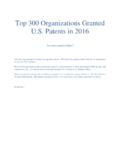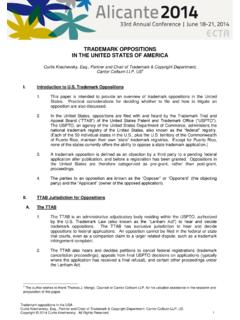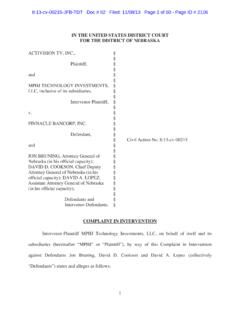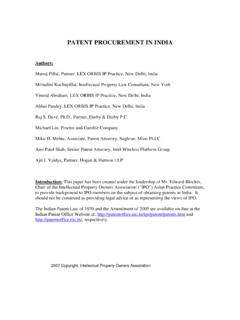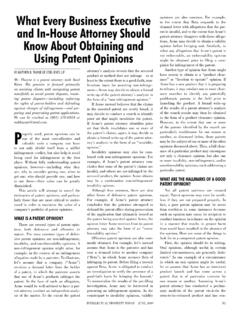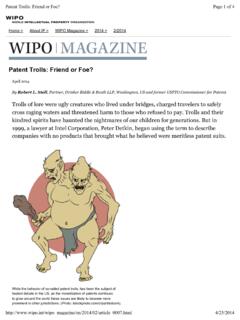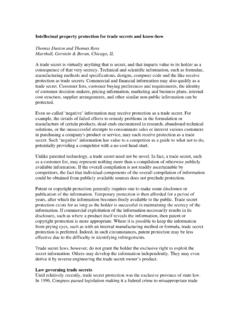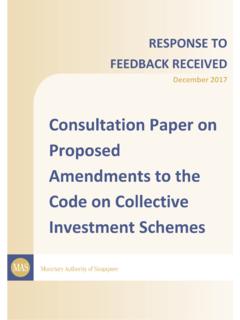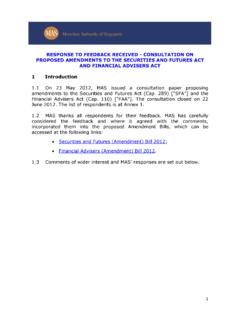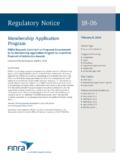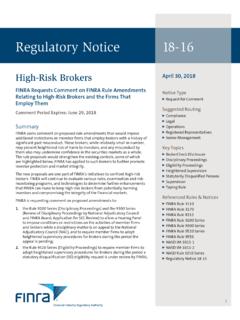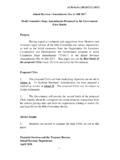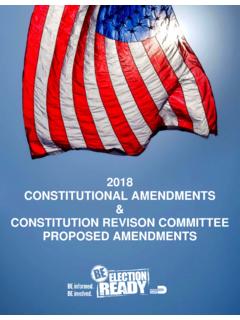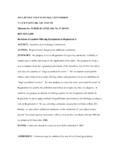Transcription of 7 February 2017 PROPOSED AMENDMENTS TO PATENT ELIGIBLE ...
1 Section 101 Legislation Task Force 7 February 2017 PROPOSED AMENDMENTS TO PATENT ELIGIBLE SUBJECT MATTER UNDER 35 101 1. ISSUE: Whether the IPO should adopt a resolution supporting an amendment to 35 101 to restore the scope of PATENT ELIGIBLE subject matter that has been restricted by the Supreme Court s decisions in Bilski, Mayo, Myriad, and Alice. 2. PROPOSED RESOLUTION: RESOLVED, that IPO supports legislation to amend 35 101 as follows: 101(a) ELIGIBLE SUBJECT MATTER Whoever invents or discovers, and claims as an invention, any useful process, machine, manufacture, composition of matter, or any useful improvement thereto, shall be entitled to a PATENT for a claimed invention thereof, subject only to the exceptions, conditions, and requirements set forth in this Title. 101(b) SOLE EXCEPTION TO SUBJECT MATTER ELIGIBILITY A claimed invention is ineligible under subsection (a) if and only if the claimed invention as a whole, as understood by a person having ordinary skill in the art to which the claimed invention pertains, exists in nature independently of and prior to any human activity, or exists solely in the human mind.
2 101(c) SOLE ELIGIBILITY STANDARD The eligibility of a claimed invention under subsections (a) and (b) shall be determined without regard as to the requirements or conditions of sections 102, 103, and 112 of this Title, the manner in which the claimed invention was made or discovered, or the claimed invention s inventive concept. 3. BACKGROUND AND PROPOSAL: A. Executive Summary The IPO 101 Task Force proposes legislation to address recent Supreme Court decisions Bilski v. Kappos, 1 Mayo Collaborative Servs. v. Prometheus Labs.,2 Ass n for Molecular Pathology v. Myriad Genetics, Inc.,3 and Alice Corp. Pty. Ltd. v. CLS Bank Int l,4 (collectively, the 101 Decisions ) that have dramatically narrowed the scope of PATENT protection for life sciences and 1 561 593 (2010). 2 566 __, 132 S. Ct. 1289 (2012). 3 569 __, 133 S. Ct. 2107 (2013). 4 573 __, 134 S. Ct. 2347 (2014). 2 software technology by significantly expanding the judicially-created exceptions to PATENT - ELIGIBLE subject matter.
3 The PROPOSED legislation will: (a) reverse the recent Supreme Court rulings and restore the scope of subject matter eligibility to that intended by Congress in the passage of the PATENT Act of 1952 ( the 1952 Act ); (b) define subject matter eligibility more clearly and in a technology-neutral manner; (c) require an evaluation of subject matter eligibility for the invention as a whole; and (d) simplify the subject matter eligibility analysis for the PATENT Office, courts, PATENT applicants, patentees, and the public by prohibiting consideration of inventiveness and patentability issues under 35 102, 103, and 112 in the 101 analysis. The analysis developed in the 101 Decisions is contrary to Congressional intent, too restrictive, technologically incorrect, unsound from a policy standpoint, and bad law. After the Alice decision, the Federal Circuit quoted from Bilski that In choosing such expansive terms .. modified by the comprehensive any, Congress plainly contemplated that the PATENT laws would be given wide scope.
4 5 Further, the Federal Circuit has recently recognized that [a] too restrictive test for PATENT eligibility under 35 101 with respect to laws of nature (reflected in some of the language in Mayo) might discourage development and disclosure of new diagnostic and therapeutic methods in the life sciences, which are often driven by discovery of new natural laws and phenomena. 6 [I]t is unsound to have a rule that takes [certain] of the realm of PATENT -eligibility on grounds that they only claim a natural phenomenon plus conventional steps, or that they claim abstract concepts. 7 In his dissent in Diamond v. Diehr, Justice Stevens stated that the cases considering the patentability of program-related inventions do not establish rules that enable a conscientious PATENT lawyer to determine with a fair degree of accuracy which, if any, program-related inventions will be patentable. 8 Today, 44 years later, the same criticism applies. The PROPOSED legislation addresses these concerns.
5 B. Analysis 1. Background This section discusses the evolution of PATENT eligibility from the passage of the 1952 Act through subsequent interpretation by the Supreme Court. As will be appreciated, the issues faced today arise from the Court s attempts to reconcile the 19th century judicial decisions on patentability with the statutory language of 101. Judicial reasoning has been strained and, as a result, a claimed process may not be a process and a claimed product may not be a product under the statute despite involving or resulting from human activity. Similarly, inventions that can only be practically implemented by computer systems are deemed to be nothing more than mental steps performed by humans. 5 Allvoice Developments US, LLC v. Microsoft Corp., 612 Fed. Appx. 1009 (Fed. Cir. 2015) (quoting Bilski, 561 593, 601 (2010) and Diamond v. Chakrabarty, 447 303, 308 (1980)). 6 Ariosa Diagnostics, Inc.
6 V. Sequenom, Inc., 809 1282, 1286 (Fed. Cir. 2015) (order denying for request for en banc hearing) (Dyk, J., concurring). 7 Id. (Lourie, J., concurring). 8 Diamond v. Diehr, 450 175, 219 (1981) (Stevens, J., dissenting). 3 The Court s prime justification for the judicial exceptions to section 101 is that a PATENT claim should not wholly preempt a natural law, phenomenon, or product or an abstract idea, and thereby foreclose future innovation. To substantiate its reasoning the Court has often referred to fundamental laws of nature such as E=mc2, implying a broad impact on future development should any natural phenomena or abstract idea be patented. Yet at the same time, the Court has held that that the prohibition cannot be avoided even when a claim is narrowly limited to a specific technological This is precisely how inventors implement inventions that make use of natural laws by applying them to specific technological fields. Thus, the Court s framework is entirely inconsistent with the very nature of technological innovation.
7 Before 1952, PATENT law relied on an arbitrary and subjective invention standard of patentability. Courts routinely invalidated patents for lacking an inventive aspect, without ever defining what makes something inventive. 10 In part as a reaction to this subjective invention standard, Congress passed the PATENT Act of 1952 with the intent that the scope of PATENT - ELIGIBLE subject matter be broad and that patentability would be determined on objective basis. This approach was codified in section 103, which bases patentability on non-obviousness, using the objective standard of a person of ordinary skill in the art. Concomitantly, Congress precluded the concept of inventiveness from the eligibility Since then, the Supreme Court s judicial exceptions have narrowed Congress s intended scope of subject matter eligibility by importing into the eligibility analysis the very same approach that Congress intended to exclude. Most recently, the 101 Decisions have paved the way for a return to the subjective inventiveness" approach, conflating aspects of 35 102, 103, and 112 with the 101 analysis and expanding the inventive concept requirement even beyond the old invention standard.
8 The results have been dramatic. The lower courts have followed the letter and apparent spirit of the 101 Decisions to their full extent, sometimes despite misgivings of some 9 Bilski, 561 at 610. 10 See Hotchkiss v. Greenwood, 52 248, 267 (1850) ( [F]or unless more ingenuity and skill in applying the old method of fastening the shank and the knob were required in the application of it to the clay or porcelain knob than were possessed by an ordinary mechanic acquainted with the business, there was an absence of that degree of skill and ingenuity which constitute essential elements of every invention. In other words, the improvement is the work of the skilful mechanic, not that of the inventor. ); McClain v. Ortmayer, 141 419, 427 (1891) ( The truth is the word [invention] cannot be defined in such manner as to afford any substantial aid in determining whether a particular device involves an exercise of the inventive faculty or not.)
9 ; Hollister v. Benedict & Burnham Mfg. Co., 113 59, 73 (1885) (invention is [t]he creative work in the inventive faculty. ); Atlantic Works v. Brady, 107 192, 200 (1882) (invention is A substantial invention or discovery. ); Potts v. Craeger, 155 597, 608 (1895) (invention is the Exercise of the inventive faculty the creative faculty, inventive skill, or inventive effort. ); Cuno Eng g Corp. v. Automatic Devices Corp., 314 84, 91 (1941) (invention requires the flash of creative genius. ); Thurber Corp. v. Fairchild Motor Corp., 269 841, 849 (5th Cir. 1959) (Invention is [s]omething new, unexpected, and exciting. ). 11 [T]he terms invent, inventor, inventive, and the like are unrelated to deciding whether the statutory requirements for patentability under the 1952 Act have been met.. Terms like inventive application and inventive concept no longer have any useful place in deciding questions under the 1952 Act, notwithstanding their universal use in cases from the [19th] century and the first half of [the 20th].
10 In re Bergy, 596 at 961 (Rich J.). 12 See Synchronoss Techs., Inc. v. Dropbox Inc., No. 16-cv-00119-HSG ( Cal. Dec. 22, 2016) ("This Court agrees with those judges who have observed that even post-Enfish, the Mayo/Alice test provides limited practical guidance for distinguishing software and computer patents that are valid under 101 from those that are not. ); Amdocs, 2016 WL 6440387, at *4 ( [A] search for a single test or definition [of what an abstract idea encompasses] in the decided cases concerning 101 from this court, and indeed from the Supreme Court, reveals that at present there is no such single, succinct, usable definition or test. ); Intellectual Ventures I LLC, 838 at 1329 (describing the semantic gymnastics entailed in applying the Mayo/Alice test to software patents) (Mayer, J., concurring); BASCOM Glob. Internet Servs., 827 at 1352, 1354 ( I have come upon no guide to when a claim crosses the boundary between unacceptable abstractness and acceptable specificity.)
